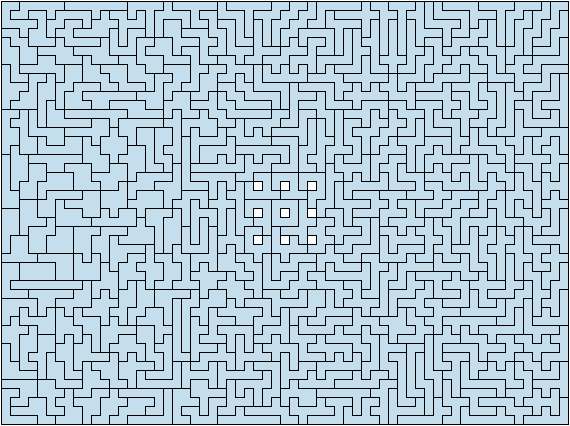An interesting set of pieces brought to my attention in some discussions on the Puzzle Fun Facebook group a while ago. Basically, you take a monomino that's been sliced in half diagonally and add it to a tetromino, creating a shape with an area of 4.5 square units. There are 44 ways of doing this, yielding a total area of 198 units² which divides up nicely in various ways.
 |
| The full set in (almost) an 11x18 rectangle. Laser cut from MDF then coloured in a way that looks like a six year old did it. |
These pieces aren't quite a continuation of ideas from the 3½-ominoes I discussed here; there's a subtle difference. I think those were created by taking a tetromino and removing a half-square, meaning there are pieces like the ones below that are essentially a monomino and domino bridged together by the triangle, which can't happen if we're determining the piece set additively like we are doing here.
 |
| Fig. 1: The original set of '3½-ominoes, with the two pieces that can't be thought of as augmented triominoes shown in dark orange. |
So twelve of the 14 3½-ominoes are of the same sort as these tetromino+tan shapes. And actually that's nice because combining those twelve with our 44 here gives a total of 198 + 42 = 240 square units. Which means rectangles ahoy. And the fact 12 and 44 both divide by 4 means we should be able to solve four small congruent rectangles, each with 11 big pieces and 3 small pieces. In theory...
But first, things you can do with just the 4½'ers on their own.
Rectangles
198 divides up nicely: 2x3x3x11. Which means rectangles of 6x33, 9x22 and 11x18 are all possible (I'm not actually sure if 3x66 is possible - it seems too thin and the pieces that look like mutilated X and Z pentominoes might cause issues since they'll touch two sides of the rectangle no matter how they're oriented. Might need further investigation). I've so far managed to solve the 11x18 (the shape of the tray I made to hold the pieces) and the 9x22, but I haven't yet had a crack at the 6x33. Call it an exercise for the reader.
 |
| Fig. 2: The pieces in a 9x22 rectangle. I didn't bother digitising it because the piece boundaries are nice and clear with these. |
Notice that each piece has one unit of diagonal edge with which it touches another piece, and that this pair of pieces combines to make (effectively) an enneomino - see the image below, where I've drawn on a few of these pairs. This is how I solved the latter half of the above rectangle (and is in fact my go-to technique for solving with these shapes). Once you've burned through all the really scary tricky pieces, pair the rest up to make nice chunky likely-looking enneominoes and tile the remaining shape with those, so as to not be left with any diagonal edges that are too awkward or concave to fill with any of the remaining pieces. Sometimes you find yourself with one of those pieces that's a P-pentomino with a slice taken out of it, and nothing that'll reach inside and fill it.
 |
| Fig. 3: Enneominoes made up of pairs of pieces marked a bit more clearly. (The other pieces make pairs too, but these were the deliberate ones.) |
Doing this technique reduces the puzzle to something a bit more rectilinear which is perhaps easier for the human brain to deal with then all those 45° angles. And additionally, the choice of enneominoes you end up with isn't set in stone, quite often the pieces are interchangeable (e.g. two pieces can fit together in two different ways to make a sort of adaptable Swiss-army enneomino) which makes things easier still.
Easier, but not easy. These things are still way trickier than the likes of polyominoes and polyhexes by my reckoning.
Non-rectangular Shapes
198's proximity to 200 means that the following 'rounded' rectangle with clipped corners is possible:
In fact, I think I'm only really just scratching the surface of what can be done with this set, so expect a 'Part 2' post in the future. (In about, what... 2029, if the recent blog posting schedule here is anything to go by...)
Combining the 3½- and 4½-ominoes
As mentioned before, the 44 pieces of size 4.5 and the 12 of size 3.5 give a total area of 240 square units. And even better, since there's a sprinkling of smaller pieces in there, the solves should be (fingers crossed) slightly easier than a solve with just the 4½-ominoes alone.
 |
| Fig. 4 or 5, I lost count: Two 11x11 squares with centre holes, filled with the 3½- and 4½-ominoes. |
Here's one such construction, using the 44 4½-ominoes and the 12 3½-ominoes (six in each square). After having solved this I take back what I said just before about them potentially being easier - there's really not much in it. Though I do think the pieces I'm saving for late in the game are not the best. I perhaps need to focus more on saving useful pairs of pieces than individual pieces, which I'm not really doing.
I have one more final thought that occurred to me while I was drawing up the image for that last solution - these sets of pieces ought to allow eight pieces to meet at a vertex. Is it possible in practice to find solutions (to any fairly regular shape) that include this mythical 8-way corner? Looking through the solutions in my notes there's a few that have corners where five pieces meet, but that's the maximum so far. I imagine you'd need to start with the eight touching pieces first, and build outwards.
































